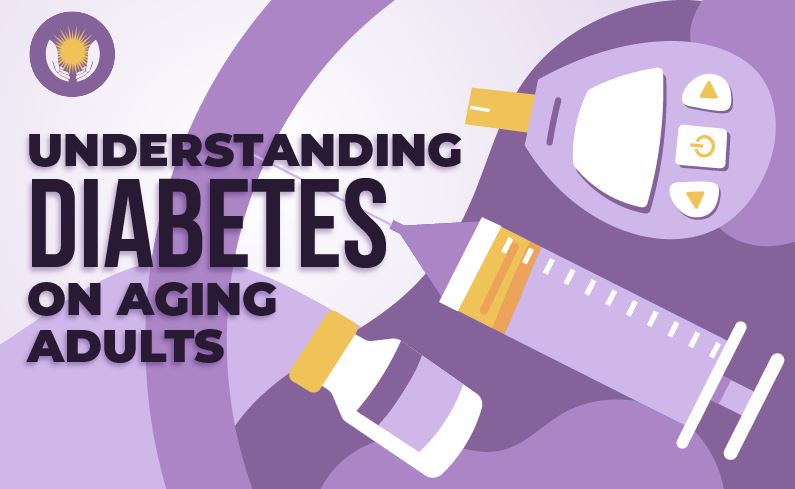Understanding diabetes on Aging Adults [Infographic]

Diabetes is a disorder of metabolism, which is how our bodies digest food for growth and energy. Most of the food we eat is broken down into glucose, the form of sugar in the blood. Glucose is the main source of fuel for cells in the body. When someone has diabetes, the body does not produce or use insulin properly, which is a hormone needed to convert sugar, starches, and other food into energy needed for life.
The CDC estimates that by 2050, 1-in-3 adults could have the disease and that around 25% of adults over the age of 65 will be affected. Keep yourself and your loved ones protected and informed about prevention and techniques to control diabetes.

3 Main Types of Diabetes
- Type 1 Diabetes– Type 1 diabetes accounts for about 5% to 10% of diagnosed diabetes in the United States. In diabetes, the immune system attacks and destroys the insulin-producing beta cells in the pancreas. The pancreas then produces little or no insulin. A person who has type 1 diabetes must take insulin daily to live. If not diagnosed and treated with insulin, a person with type 1 diabetes can lapse into a life-threatening diabetic coma, also known as diabetic ketoacidosis.
- Type 2 Diabetes – The most common form of diabetes is type 2 diabetes. About 90% to 95% of people with diabetes have this type. This form is most often associated with older age, obesity, family history of diabetes, and physical inactivity. The symptoms of type 2 diabetes develop gradually. Their onset is not as sudden as in type 1.
- Pre-diabetes– also called impaired fasting glucose (IFG) or impaired glucose tolerance (IGT), means you have blood glucose levels that are higher than normal but not high enough to be called diabetes. Too much glucose in your blood can damage your body over time. Pre-diabetes is becoming more common in the U.S., according to new estimates provided by the Department of Health and Human Services. About 40% of adults ages 40 to 74 have this condition. These people are at risk of developing full-blown type 2 diabetes within 10 years.
5 Common Complications from Diabetes
- Heart disease: According to the American Diabetes Association (ADA), approximately two out of three people living with diabetes die due to heart disease. Diabetes affects cholesterol levels; raising a person’s bad cholesterol while lowering their good cholesterol. When this happens, arteries are narrowed by a build-up of fatty materials, and the chances of having a heart attack or stroke double.
- Neuropathy: It is likely that almost half of the people with diabetes have nerve damage, says the ADA. This condition causes loss of sensation and makes it easier for a person to injure themselves without noticing. Additionally, poor circulation and neuropathy often lead to a compromised immune system, as the body can’t fight off infection or heal from wounds quickly.
- Foot problems: Poor circulation and nerve damage can lead to infections of the foot that may become serious, spreading to the bone and leading to amputation. If a diabetic experiences a cut or other injury to their foot, they should keep it clean and notify their doctor immediately.
- Dementia: A 2010 study published by Neurology discovered a connection between dementia risk and diabetes. The researchers followed more than 1,000 people for 15 years in an attempt to uncover a link between the two illnesses. As a result, 27% of people with diabetes developed dementia throughout the study, as opposed to only 20% of non-diabetics. This link means that as many as one-quarter of Americans over the age of 60 could have a significantly increased risk for Alzheimer’s and other types of dementia.
- Kidney failure: The National Institutes of Health (NIH) indicates that diabetes is the most common cause of kidney failure. Although this condition takes about 15 years to develop, it is a slow-growing problem that those living with diabetes should monitor by paying attention to fatigue, an increase in urination frequency, lack of concentration, sleep trouble, muscle cramping at night, lack of appetite, eye puffiness and swollen feet/ankles.
Staying healthy is a challenge for everyone, but for those managing diabetes, staying on top of changes to health status is crucial. According to the CDC, diabetes is the seventh leading cause of death and can lead to permanent disability.
3 Things You Can Do To Prevent Diabetes:
- Track your glucose levels. As we age we should be on top of our health, which includes checking your glucose to get the A1C test.
- Make healthy food choices. The food you eat affects glucose levels, so it’s important to learn what’s best for you to eat, how much, and when
- Be active. Walking and other forms of daily exercise can help improve glucose levels in older people with diabetes.


Comments